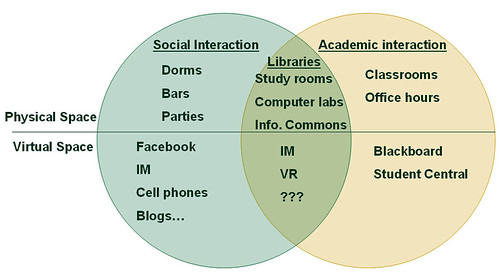I have not yet been able to read all of the comments for “The Central Problem of Library 2.0: Privacy” by Rory Litwin, but would like to share my current views on this very important issue. I have previously blogged about my recent use of social networking software and blogs, but I haven’t yet touched on the idea of privacy. Like community, I became very interested in privacy issues while working at the Northborough Free Library. While there, I dumped all of their interlibrary loan records, helped rewrite their computer use policy to reflect the recent passing of the USA PATRIOT Act, and changed the settings on the public access computers to eliminate patron browsing records. When I came to graduate school I did not exist on the web and was proud of it.
I am still very concerned about patron privacy and I remain slightly paranoid about my web presence. However, given my profession, it is important to have a web presence. Furthermore, I want one. I am tired of being paranoid about what potential employers may think when reading my blog or googling me. This doesn’t mean that I don’t expect them to google me. In fact I encourage it. However, I do my best to maintain a professional presence and to control the amount and type of information that is available about me. ClaimID was created with this function in mind and is the type of tool that everyone will need in the future.
As Rory mentioned, many millennials (which by some definitions I am, though I think of myself as GenX), lack the concerns for privacy needed to responsibly manage their personal information. However, while Rory chalks this up to immaturity, I would argue that it is more a lack of proper education. While we would all like private corporations to take responsibility for educating their users in responsible use of their services, this is not realistic. It is for this reason that information literacy training is fast becoming one of the most important services provided by a library. Under the Library 1.0 model, library patrons were consumers of information resources, now they are also contributors. Consequently, I have come to believe that we, as librarians, need to educate our users to be responsible contributors to Web 2.0 and Library 2.0 services. So then what does one need to know to be a responsible contributor?
There are three issues that I think librarians need to educate their users on.
1. Privacy
2. Ownership
3. Security
The first two Rory touched on, but I would like to add a little. We need to teach our users that it is their responsibility to control their personal information. Library 2.0 involves “radical trust” of our users. This radical trust means a significant loss of control. As much as we would like to protect them, we can’t always. With our Library 2.0 services, we need to be clear about what information patrons will be sharing and give them control. We also need to educate them on how to use commercial services. As Rory mentioned, this gets into the second issue, ownership.
We need to educate our users about copyright. The read/write web makes everyone an author. Thus far, the education system has failed to teach people about intellectual property. Librarians are all about providing information for free. Not many other people are. Information is a very valuable commodity and librarians have to remember this when educating their patrons.
We need to have excellent security measures in place. I am more afraid about my credit card company getting hacked for my data than I am about the information I choose to share about myself. It is important that we build secure systems so that we can keep our patrons information safe.
All this being said, I often worry about whether what I am about to post will cost me a job someday. Yesterday, my mom and stepfather both commented that I looked kind of scraggly in the picture I had in my sidebar and that I should chose a different picture if potential employers might be reading my blog. The picture is down now. It is still all over the web however. I have tried to separate my professional and personal online lives the best I can. I don’t try to hide my personal life, but I try to make sure that potential employers will recognize the differences between my serious LinkedIn/ClaimID side and my social Myspace/Friendster side. That is the type of distinction we need to get our users thinking about.
library 2.0web 2.0 academiclibrary20
